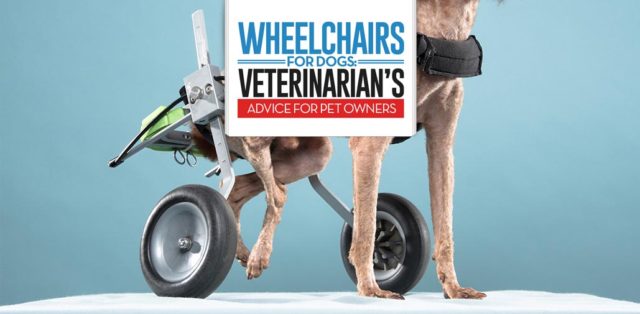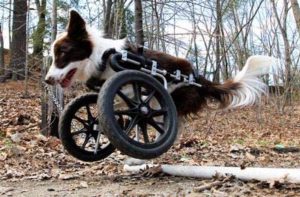
Today, mobility options for special-needs dogs have become widely available. If your dog is in need of temporary or permanent mobility assistance, a wide number of carts, walking sling harnesses, and wheelchairs for dogs may be one of the answers, if not the only answer.
Table of Contents
- Vet's Guide on Wheelchairs for Dogs
How to Choose Mobility Assistance
- 1. Where to Start?
- 2. Consider Seeing a Specialist
- 3. What's a “Towel Test”?
- 4. What Type of Mobility Device is Best?
- Rear Limb Wheelchair and Mobility Support
- Forelimb Wheelchair and Mobility Support
- Full-Body Mobility Support
- 5. Start Using Mobility Support Early
- 6. Where to Look for Wheelchairs for Dogs?
- 7. Dog Wheelchair DIY Style
- 8. Dog Wheelchair Training
- 9. Troubleshooting and Fitting Issues
In my practice, I often see pets that require such support, but pet owners are sometimes confused about which mobility assistance option is best for their canines. Most can be found online, and manufacturers can even make custom devices for your dog’s particular needs and within your budget, whether it's carts, slings, or wheelchairs for dogs.
But despite this god-send to special needs dogs everywhere, the number of options can be overwhelming. If you're already certain that your pooch needs a wheelchair, there are plenty of great dog wheelchair options available. And if you're unsure which assistance is best for your dog and how to pick the right one, I'll walk you through the process here.
Vet's Guide on Wheelchairs for Dogs
How to Choose Mobility Assistance
1. Where to Start?
Begin with a consultation with your veterinarian about your pet's current situation and possible options. The type of mobility support that your dog needs can depend heavily on your dog’s primary mobility problem or diagnosis. Wheelchairs for dogs, slings and harnesses, carts, and other options all come with their set of pros and cons, so it's best to eliminate as many disadvantages as possible and prioritize comfort for your Fido.
Your vet will know whether you need a temporary or permanent option and guide you in the right direction. They have no vested interest in this area, thus it's the only place where you can get unbiased advice on buying a product. They will help you pick the right choice that will maximize your dog’s quality of life and minimize any potential fitting issues.
Suppose your veterinarian is inexperienced in this area. In that case, he or she may still be able to point you in the right direction in terms of finding the right specialist or manufacturer.
2. Consider Seeing a Specialist
Your veterinarian may recommend seeing a dog mobility assistance specialist before ordering a particular device. These specialists will often include veterinary neurologists, surgical specialists, canine rehabilitation, and physiotherapy specialists – all of them are very valuable assets when it comes to ordering and fitting mobility devices for dogs.
Note that many specialists have working relationships with companies that make customized mobility carts and wheelchairs for dogs. It's possible that they get a kickback from referring you, but this can also be a more cost-effective way of acquiring a device than simply purchasing one on your own.
3. What's a “Towel Test”?

Before you pick the right type of wheelchair or cart, you'll need to know what you're looking for. Most leading makers of canine mobility devices and wheelchairs for dogs recommend using the “towel test” to help determine which dog wheelchair is best for your pooch.
The “towel test” helps you and your veterinarian determine the strength of your dog’s forelimbs. The abdomen and hips are supported by a long towel (or a shopping bag in the above photo), and the feet are not allowed to touch the ground. If your dog is strong and easily able to move forward using the forelimbs alone, a rear-support canine wheelchair may be best. If your dog stumbles or takes steps with difficulty, a forelimb or full-body support wheelchair is recommended.
The “towel test” was covered with details in the dog sling harness article on how to measure your Fido for mobility assistance devices. You'll know exactly how to perform the test and also measure your dog for other mobility options. If you're looking for a visual demonstration, I recommend watching Samantha's DIY dog rear leg sling video.
4. What Type of Mobility Device is Best?
No single mobility assistance option will work for every dog with movement disabilities. The best choice will depend on your dog’s particular problem or diagnosis, as well as the results of the “towel test.” This is why it's a good idea to discuss it with a vet.
There are three types of wheelchairs for dogs and other mobility assistance devices that are most popular and cover about 99% of dogs with these movement issues. Those are:
- Rear Limb Wheelchair and Mobility Support
- Forelimb Wheelchair and Mobility Support
- Full-Body Mobility Support
Let's cover all three of these in more detail so you know which one works for you.
Rear Limb Wheelchair and Mobility Support
Most pet owners looking at purchasing wheelchairs for dogs usually need them for the dog's rear limbs. These dogs are typically very strong in their forelimbs and otherwise want to be active.
Designs of rear limb wheelchairs vary, but they typically attach to the dog using a torso and/or chest harness. A support bar or “saddle” is placed under their abdomen and either allows the legs to touch the ground or not. Dogs with some mobility can benefit from having their feet touch the ground. This type of feature can help dogs successfully regain mobility after rehabilitation.
Different types of abdominal support bars and straps may be necessary depending on your pet’s support needs. The proper type of support not only improves mobility but can also help to decompress the spine and relieve aching muscles in your dog.
Dogs with the following conditions may benefit from rear limb mobility support:
- Arthritis
- Generalized weakness
- Degenerative Myelopathy
- Ruptured Disc
- Trauma
- Rear limb amputation
- Post-surgical rehab for knee, spine or hip
- Intervertebral Disc Disease (IVDD)
- Hip Dysplasia
Your vet or a specialist will help you determine which bar type or straps are best for which condition.
Forelimb Wheelchair and Mobility Support

For dogs with forelimb issues, usually caused by paralysis or amputation, a number of options are readily available, too. Most patients that are recovered from an amputation can function without the assistance of a sling or wheelchair for dogs. However, there are situations where the remaining limb is weak or otherwise affected by severe arthritis pain, so a mobility device is often necessary, even if it is temporary.
Forelimb support wheelchairs for dogs are most helpful for those with mild to severe forelimb weakness or dysfunction. Some models can help to remove about 70% of the weight bearing on the front legs of the dog. Headrests can also be added on for extra support and relief of pain.
Dogs with the following conditions can benefit from forelimb support:
- Post-surgical support for knees, disc, hip
- Degenerative Myelopathy
- Ruptured Disc
- Cerebellar hypoplasia
- Intervertebral Disc Disease (IVDD)
- Arthritis
- Amputation
- Spinal Trauma
- Generalized Weakness
Consult with your veterinarian and do the tests to see how weak your dog is in this area to decide how much mobility support will be needed.
Full-Body Mobility Support
Full-support models of wheelchairs for dogs are necessary for patients with forelimb and rear limb weakness or partial paralysis. Many of these pets will stumble and fall as they attempt to walk, thus full mobility support is usually the only available option.
These devices are the most expensive. Models can come with multiple settings to ensure the right amount of support for the dog, from light to full support. These types of dog wheelchairs can also help to relieve stress along the spine if your pet has spinal disease or is post-surgery.
Your dog may benefit from a full-body wheelchair if they have one of these conditions:
- Post-surgical support for knees, disc, hip
- Degenerative Myelopathy
- Ruptured Disc
- Cerebellar hypoplasia
- Intervertebral Disc Disease (IVDD)
- Arthritis
- Amputation
- Spinal Trauma
- Generalized Weakness
Again, because full-body mobility devices are expensive, it's best to consult with a specialist to decide whether you really need this type of assistance or something lighter.
ALSO READ: 6 Vet’s Tips on How to Care for Senior Dogs
5. Start Using Mobility Support Early
Paralyzed pets or those completely unable to walk aren't the only ones for whom pet owners should consider mobility support. For example, dogs with generalized weakness and just a little difficulty walking can benefit from some extra support to prevent further issues. The longer you delay, the worse the condition may become.
Even cancer patients can benefit from a dog wheelchair or sling harness when they are feeling weak. Finding the right type of expert in this area is crucial. Veterinarians who specialize in end-of-life and palliative care “doggie hospice” recommend investing in mobility devices if an older pet’s health is deteriorating. It is best to find an appropriate device early to maximize your pet’s best function and comfort.
6. Where to Look for Wheelchairs for Dogs?
Most reputable companies sell wheelchairs for dogs online, complete with professional, personalized support for customizing your device to fit your ailing pooch. Some companies work directly with veterinary specialists, while many others are accessible without a referral.
From my personal experience, I found that dog wheelchairs or other mobility support measurement information and directions are always included with each model, and questions are answered promptly by phone or internet message.
Most designs of wheelchairs for dogs are very similar to one another, but some may be very custom and unique to your and your pet’s mobility needs. Cost can vary widely depending on your dog’s size, weight, and support requirements.
Some pet wheelchairs are combinations of hoists, slights, and mobility wheels. Tires and wheels can be custom-ordered. For example, if your Border Collie likes to run in the fields or on trails, consider a dog wheelchair with suspension and more aggressive tread for rougher terrain. City-walk type of wheelchairs will probably come apart sooner.
If you're looking for specific examples, this list of 7 Best Dog Wheelchairs has a great selection of proven options that the majority of pet owners found success with. In terms of specific manufacturers, I personally found a few. For example, in North America, the following purveyors are available (among others that you may find yourself):
- K-9 Carts: www.k9carts.com
- Eddie’s Wheels: www.eddieswheels.com
- Doggon’ Wheels: www.doggon.com
- Dewey’s Wheelchairs for Dogs: www.wheelchairsfordogs.com
- Walkin’ Pets: www.handicappedpets.com
I would recommend not to impulse buy and first make a few picks, and bring those to your vet or a specialist of your choice to discuss and make your final choice. It's always a good idea to read through customer reviews, and since many of these manufacturers sell on Amazon, that may be a good place to start your research.
7. Dog Wheelchair DIY Style

The cost of wheelchairs for dogs can be a hurdle for many families. While there's a wide variety of options to choose from, majority of them are pretty expensive. This is especially true if you have a medium or large-size dog breed that requires full body support – those dog wheelchairs often run anywhere from $250 to $500 each.
Fortunately, there are numerous resources available online for building your own dog wheelchair DIY style. As long as you educate yourself on proper construction (you can use this DIY dog wheelchair guide), making your own DIY dog wheelchair can save you hundreds of dollars. Most commonly, inexpensive materials can be used, such as second-hand bicycle or stroller wheels and lightweight PVC piping.
8. Dog Wheelchair Training
One thing pet owners often forget to consider is that, unlike us, it's not self-explanatory to dogs how to move around when there's a mobility support device attached to their bodies. Therefore, consistent training is an important part of life in the wheelchair. Some dogs take to it like ducks to water, but others find the transition to be difficult or even frightening.
When introducing your dog to their new mobility device, be sure to make it an easygoing experience. All common sense dog training tips apply here to avoid fostering anxiety in dogs that will be related to wheelchairs. Let your dog sniff it, gently hook it to the body, and stop if your pooch struggles or becomes afraid. Reward every move with a tasty treat. Reward-based training will go a long way in helping your furry pal to accept their new ride.
Take things very slowly. If your dog tolerates being in the wheelchair, reward heavily and only keep them in it for a short time. Give long breaks between sessions. Once they start to move around in it, reward it every step of the way with treats and praise.
If you feel like your dog is not accepting their new wheelchair or you’re having training difficulties, don’t hesitate to contact your veterinarian or a local dog trainer for help. The above-mentioned canine mobility specialists are also well-versed in training pets to use their new support devices.
9. Troubleshooting and Fitting Issues
 One of the biggest problems with doggie wheelchairs is ensuring a proper fit. While this is not such a huge challenge for most customized wheelchairs for dogs, some “tweaking” may need to happen with the straps and harnesses. A snug fit is necessary for stability and comfort. If your pet has thin hair or skin or loses weight, the fittings can quickly become out of balance.
One of the biggest problems with doggie wheelchairs is ensuring a proper fit. While this is not such a huge challenge for most customized wheelchairs for dogs, some “tweaking” may need to happen with the straps and harnesses. A snug fit is necessary for stability and comfort. If your pet has thin hair or skin or loses weight, the fittings can quickly become out of balance.
These fitting issues can lead to rubbing, irritated skin, and pressure sores. An ill-fitting dog wheelchair can be like wearing an ill-fitting shoe – mobility is decreased, and blisters can form from rubbing. This is worse than having no mobility support.
I've had pet owners come into my clinic asking for advice on how to deal with sores and blisters from a mobility device. The answer is that there should be no sores or blisters, and if you're encountering them, then you either purchased the wrong type of wheelchair for dogs or you haven't properly adjusted it for your pooch.
If you find that the harnesses are rubbing, be sure to seek veterinary attention – sores can quickly become infected. This will not only hurt your dog and cause health problems but also prevent him from using a mobility support device in the future. If this happens, extra padding or bandages may be necessary to keep your pet in the wheelchair while these spots are healing.
READ NEXT: 8 Signs Your Dog Is Experiencing Joint Pain















